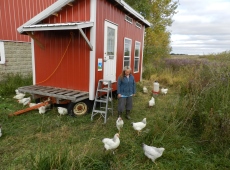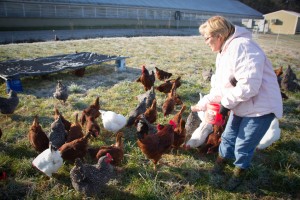The Poultry Farmer
 The management of free-range birds can be labor intensive and complicated by the uncontrolled environmental conditions and unpredictable diet composition (Miao et al., 2005). It has been suggested that there is a greater need for a skilled stockperson in free range systems than there is in caged systems (Barnett, 1999). Ensuring that conditions such as feather-pecking are kept under control can require high levels of management (Menke et al., 2004). Further, as with all farmed animals, a good understanding of the basic behavioral needs of the animals in our care is a prerequisite to achieving high standards of welfare.
The management of free-range birds can be labor intensive and complicated by the uncontrolled environmental conditions and unpredictable diet composition (Miao et al., 2005). It has been suggested that there is a greater need for a skilled stockperson in free range systems than there is in caged systems (Barnett, 1999). Ensuring that conditions such as feather-pecking are kept under control can require high levels of management (Menke et al., 2004). Further, as with all farmed animals, a good understanding of the basic behavioral needs of the animals in our care is a prerequisite to achieving high standards of welfare.
What Makes a Good Stockperson?
 Hemsworth and Coleman (2010) identify the following attributes of the modern stockperson:
Hemsworth and Coleman (2010) identify the following attributes of the modern stockperson:
- A good knowledge of the animal’s requirements, including nutritional, climatic, social and health
- Practical experience of animal care and maintenance
- The ability to identify deviations from normal behavior, health and performance and to provide or seek appropriate support when these occur
- The ability to take daily responsibility for the care and maintenance of large numbers of animals, and be able to so by working effectively either in a team or independently.
Daily Inspection
A daily inspection must be carried out to check that all birds are behaving normally and that all systems are operating properly.
Observe the flock closely for early signs of distress or disease and act on any signs of trouble or concern immediately.
If this is not obvious, or remedial action is not effective, veterinary, technical or further advice should be sought as soon as possible.
| Important indications of poultry health include: | Early signs of ill-health may include changes in: |
|
|
Injured, dead or individual sick birds should be removed promptly and disposed of according to guidelines and rules.
www.gov.uk/guidance/poultry-welfare-guidance-on-the-farm
Dealing with Predators
Offering birds protection from predation can involve considerable management time, and can also be inconvenient if this involves shutting birds away in the evenings for protection. Placing feed outdoors at night can encourage wild birds and predators and also discourage a return to the housing at night. Feeding regimes can be adjusted to encourage birds to return to houses at night, and there are examples of single pop-holes being left open overnight but with bars at 10-12 cm apart to exclude foxes (Barnett, 1999). It is much easier, using fences, barriers and housing management, to protect poultry from terrestrial predators than it is from wild bird predators such as hawks, eagles and owls.


 British English
British English

Comments are closed.